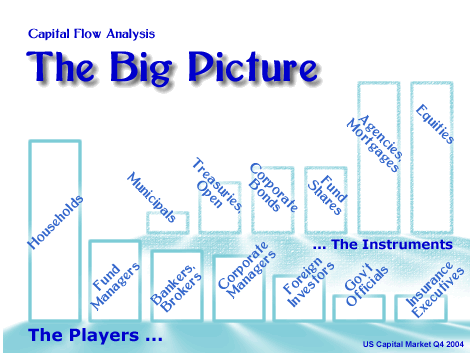Overview of the Flow of Funds in the US Capital Market: Capital Flow Analysis: The Big Picture
An overview of the U.S. capital market based on Federal Reserve national flow of funds accounts.

 Overview of the Flow of Funds in the US Capital Market
Overview of the Flow of Funds in the US Capital Market
The U.S. capital market, the largest in the world, is daunting in size and complexity.
However, using Capital Flow Analysis and Federal Reserve National Flow of Funds Accounts, we can describe the broad outlines of the market.
Seven Sectors; Six Instrument Categories
In 2004, the American capital market was made up of seven major sectors (classes of players) that traded six main categories of securitized instruments, as follows:
Sectors (Players) |
% |
Securitized Instruments |
% |
| Households | 36.3% |
Corporate Equities | 30.5% |
| Fund Managers | 16.0% |
Agency Securities & Mortgages | 29.7% |
| Bankers and Brokers | 14.6% |
Fund Shares | 12.9% |
| Corporate Managers | 12.9% |
Corporate Bonds | 12.8% |
| Foreign Investors | 9.1% |
Treasuries and Open Market | 10.2% |
| Government Officials | 5.4% |
Municipal Securities | 3.6% |
| Insurance Executives | 5.2% |
||
Total US$ trillions |
101.1 |
Total US$ trillions |
56.3 |
Total financial assets held by the principal categories of players were valued at $101.1 trillion on December 2004. Securitized instruments totaled $56.3 trillion, as shown above.
[Note: Because of difficulties in gathering data and lack of reporting from the underground economy, national flow of funds accounts should be interpreted as rough estimates.]
The sector and instrument totals, above, are different because only a portion of financial assets are securitized and traded on the market.
In December 2004, at least 40% of all financial assets were not securitized, but were held in forms such as bank deposits, savings deposits, and trade receivables.
There is also double counting in flow of funds accounts. For example, households own mutual funds and mutual funds own stocks and bonds. The same stocks and bonds are counted twice as assets of households and of mutual funds.
Further Breakdown of Sectors and Instruments
The broad sectors shown in the table are broken down further in the national flow of funds accounts.
For example, the category 'Fund Managers' is made up of seven sectors, as follows:
| Private Pension Funds |
| Local Gov't Retirement Funds |
| Federal Retirement Funds |
| Money Market Funds |
| Mutual Funds |
| ETF and Closed-End Funds |
| REITs |
In general, 'Fund Managers' hold and invest other peoples' money for a fee.
A breakdown and explanation for each of these seven sectors and six instrument categories can be found by clicking on the 'players' and 'instruments' tabs at the top of each page.
Primary Players
It is useful to think of the capital market as being composed of primary players and intermediaries.
Intermediaries are institutions that make the capital market work by providing financial services and by creating securities out of debt and equity offered by the primary players.
The four groups of primary players are:
| Households |
| Corporate Managers |
| Foreign Investors |
| Government Officials |
Households (individuals) get money to invest from wages, salaries, investment income, and accumulated wealth. Households borrow money for home ownership and consumer spending. Some household debt is converted into mortgages and asset-backed securities.
Foreigners accumulate dollars that are invested in U.S. securities, primarily by selling more goods into the American market than they purchase, but also from wealth accumulated abroad. Foreigners also issue stocks and bonds that finance business overseas.
Government officials raise money through taxes and through the sale of municipal securities and treasury bonds.
Corporate managers raise money for business purposes by selling stocks and bonds through financial intermediaries.
The motivation of these primary players has changed over the long history of the U.S. capital market.
All of these sectors, to a greater or lesser degree, are both investors in and issuers of securities. They also borrow and lend on an unsecuritized basis.
The motivation of each category of players is different.
Before proceeding, check your progress:
Self-Test
The market sector with the most financial assets is controlled by:
|
|
In December 2004, the category of securities with the greatest market value was:
|
|
Primary market players include:
|
learning Module  : continued >
: continued >